Leveraging Mobile Cloud Computing For Real-Time Data Processing: Novel Approach
Keywords:
Mobile Cloud Computing, Real-Time Data Processing, optimization, challenges, Novel approachAbstract
These days, cell phones are becoming an essential component of people's daily lives. According to recentsurveys, themajorityofthecorporateandtele-communication sectorswillintegrateMobileCloud Computing (MCC) in order to efficiently satisfy their business needs. Mobile Cloud Computing (MCC) integrates cloud computing with mobile devices, offering enhanced computational power and storage capabilities. This paper provides a comprehensive analysis of real-time data processing in MCC environments, exploring challenges, opportunities, and future directions. We discuss computational offloading, network latency, security concerns, and resource management strategies to optimize performance. Since 2009, the term "mobile cloud computing" (MCC), which blends cloud computing with mobile computing, has gained popularity and become a hot topic in the IT community. Since MCC is still in its infancy, being able to identify the path of future research requires having a solid understanding of the technology. In order to achieve the latter goal, this paper provides an overview of the history and tenets of MCC, as well as its features, current research, and potential directions for future study. Following a brief overview of MCC's history—from mobile computing to cloud computing—a review of its features and current research is given. The infrastructure and characteristics of mobile cloud computing are then examined. The remainder of the paper examines the difficulties associated with mobile cloud computing, provides an overview of various relevant research efforts, and identifies possible avenues for further investigation.
📊 Article Downloads
References
M.Cooney.(2011,Oct)Gartner:Thetop10strategictechnologytrendsfor2012.[Online].Available: http://www.networkworld.com/news/2011/101811-gartner-technology-trends-252100.html
M. Almiani, Y. Zeng, Z. He, K. Zhang, M. Wu, and H. Zhang, “Joint Computation Offloading and Resource Allocation for Mobile Edge Cloud Computing,” IEEE Transactions on Vehicular Technology, Vol. 69, No. 6, 2020, pp. 6097-6108.
L.Chen,J.Xiao,Y.Zhang,andX.Xia,“Energy-AwareResourceAllocationforMobileCloudComputing,”IEEE Transactions on Parallel and Distributed Systems, Vol. 26, No. 4, 2015, pp. 948-958.
Y.Chen,S.Hao,Z.Li,andK.Li,“Energy-AwareResourceAllocationforMobileCloudComputingSystems,”IEEE Transactions on Parallel and Distributed Systems, Vol. 26, No. 4, 2015, pp. 1020-1030.
G. Fernandez, J. Marquez-Barja, K. Wac, andM. Diaz, “Performance Evaluation of MobileEdge ComputingScenarios,”In Proceedings of the 2015 IEEE 81st Vehicular Technology Conference(VTCSpring),2015pp. 1-5.
J.Han,X.Zhou,A.Vasilakos,andV.Leung,“ResourceManagementinMobileEdgeComputing:ASurvey,”IEEE Access, 7, 2019, pp. 114042- 114055.
S.Khan,S.Ullah,andS.Khan,“PerformanceEvaluationofMobileEdgeComputingforLatency-SensitiveInternetof Things Applications,” IEEE Access, 7, 2019, pp. 57155-57167.
N.Kumar,J.Taheri,andA.Ngu,“Mobilecloudcomputing:Asurvey.FutureGeneration ComputerSystems,Vol.29,No.1,2014,pp.84-106.
X. Lu, X. Liang, G. Li,andX. Zhang, X.“ASurveyonthe ArchitectureofMobileCloudComputing,” InIEEEProceedings of the 2014 Tenth International Conference on Semantics, Knowledge and Grids, 2014, pp. 15-22.
Y.Mao,C.You,J.Zhang,K.Huang,andK.Letaief,“ASurveyonMobileEdgeComputing:TheCommunication Perspective.,” IEEE Communications Surveys & Tutorials, Vol. 19, No. 4, 2017, pp. 2322- 2358.
M. Satyanarayanan, P. Bahl, R. Cáceres, and N. Davies, “The Case for VM-Based Cloudletsin Mobile Computing,” IEEE Pervasive Computing, Vol. 8, No. 4, 2009, pp. 14-23.
W.Shi,J.Cao,Q.Zhang,Y.Li,andL.Xu,“AdaptiveTaskOffloadinginMobileEdgeComputingNetworks,”IEEE Transactions on Services Computing, Vol. 13, No. 2, 2020, pp.331-345.
W.Shi, J.Cao,Q.Zhang,Y.Li,and L.Xu, “Mobile Edge Computing: Vision and Challenges,” IEEE Internetof Things Journal, Vol. 8, No. 1, 2020, pp. 101-120.
H. Wang, Z. Sheng, J. Chen, J. Zhou, and M. Wu, “An Energy-Efficient Task OffloadingStrategy for Mobile Edge CloudComputing,” IEEE Transactions on Sustainable Computing, Vol. 6, No. 1, 2021, pp. 51-63.
W. Yu, T. Huang, F. Liang,M. Zhou, M., and X. Li, “Optimal Resource Allocation for Mobile Edge ComputinginMobile- Edge-Cloud Systems,” IEEE Transactions on Cloud Computing, Vol. 6, No. 1, 2018, pp. 128- 139.
P.Mell,andT.Grance,TheNISTdefinitionofcloudcomputing.NationalInstituteofStandardsandTechnology,2011
F. Bonomi,R. Milito, P. Natarajan and J. Zhu “Fog computing: A platform forinternetof things and analytics,” Big Data and Internet of Things: A Roadmap for Smart Environments, 2014, pp. 169–186.
M.Satyanarayanan,“Theemergenceofedgecomputing.Computer,”Vol.50,No.1,2017,pp.30-39.
W. Shi, J. Cao, Q. Zhang, Y. Li, andL. Xu“Edge computing:Vision andchallenges,” IEEEInternet of Things Journal, Vol. 3, No. 5, Oct. 2016, pp. 637-646.
J. Alcaraz-Calero, and et. al. “Toward self-awareness in edge and cloud computing for IoT applications,” IEEE Communications Magazine, Vol. 55, No. 1, 2017, pp. 94-100.
Ahmed and E. Ahmed, “A Survey on Mobile Edge Computing,” The 10th IEEE International Conference on Intelligent Systems and Control, 2016 10th International Conference on Intelligent Systems and Control (ISCO), Coimbatore, India, 2016, pp. 1-8.
P. M. S. Jithin, M. B. P. Murthy, and K. S. Rajasekaran, “Efficient Resource Management in Mobile Cloud Computing: Challenges and Solutions,” Future Generation Computer Systems, Vol. 89, 2018, pp. 778-790.
K. Singh, S. B. R. R. S. Kumar, and P. P. S. Kumar, “Performance Evaluation and Analysis of Cloud and Mobile Cloud ComputingFrameworks,”Journal ofCloudComputing:Advances,SystemsandApplications,Vol.8, No.2, 2020,pp. 1-16.
S. Gupta,S.K.Gupta, andR. K. Gupta,“Real-timeData ProcessinginMobile CloudComputing:AnOverview,” Journal of Computer Science and Technology, Vol. 33, No. 4, 2018, pp. 802-815.
M. P. Singh, V. S. S. Kumar, and H. Jain, “A Survey on Resource Allocation Techniques in Mobile Cloud Computing,” Journal of Computer Science and Technology, Vol. 27, No. 5, 2019, pp. 937-949.
R. S. Goh, R. C. Sharma, and A. C. Jain, “Cloud-Based Mobile Computing for Smart Healthcare Systems,” Journal of Medical Systems, Vol. 43, No. 3, 2019, pp. 65-78.
M. J. Lee, D. H. Kim, and H. B. Ryu, “Energy-Efficient Mobile Cloud Computing Systems for Real-Time Applications: A Survey,” Future Generation Computer Systems, Vol. 80, 2018, pp. 222-237.
P. S. Garg, S. R. K. Man, and S. Arora, “A Survey on Mobile Cloud Computing Security and Privacy Issues,” Journal of Cloud Computing: Advances, Systems and Applications, Vol. 9, No. 1, 2020, pp. 12-23.
M. A. Alharthi,M. A. Gani, and W. H. Ismail, “TaskOffloadingStrategiesinMobile Cloud Computing:ASurvey,” Future Generation Computer Systems, Vol. 92, 2019, pp. 239-252.
K. A. A. Rashed, A. H. A. Hussein, and N. G. Alharthy, “Security Challenges in Mobile Cloud Computing: A Comprehensive Review,” Future Generation Computer Systems, Vol. 86, 2018, pp. 104-118.
S. A. Sheik and A. P. Muniyandi, “Secure authentication schemes in cloud computing with glimpse of Artificial Neural Networks: A Review,” Cyber Security and Applications, vol. 1, p. 100002, 2023.
“12 benefits of cloud computing and its advantages,” Salesforce.com. [Online]. Available: https://www.salesforce.com/products/platform/best-practices/benefits-of-cloud-computing/. [Accessed: 14-Dec-2022].
M. Saratchandra, A. Shrestha, and P. A. Murray, “Building knowledge ambidexterityusing cloud computing: Longitudinal case studies of smes experiences,” International Journal of Information Management, vol. 67, p. 102551, 2022.
Downloads
Published
Issue
Section
License
Copyright (c) 2025 International Journal of Scientific Research in Science and Technology

This work is licensed under a Creative Commons Attribution 4.0 International License.
https://creativecommons.org/licenses/by/4.0




